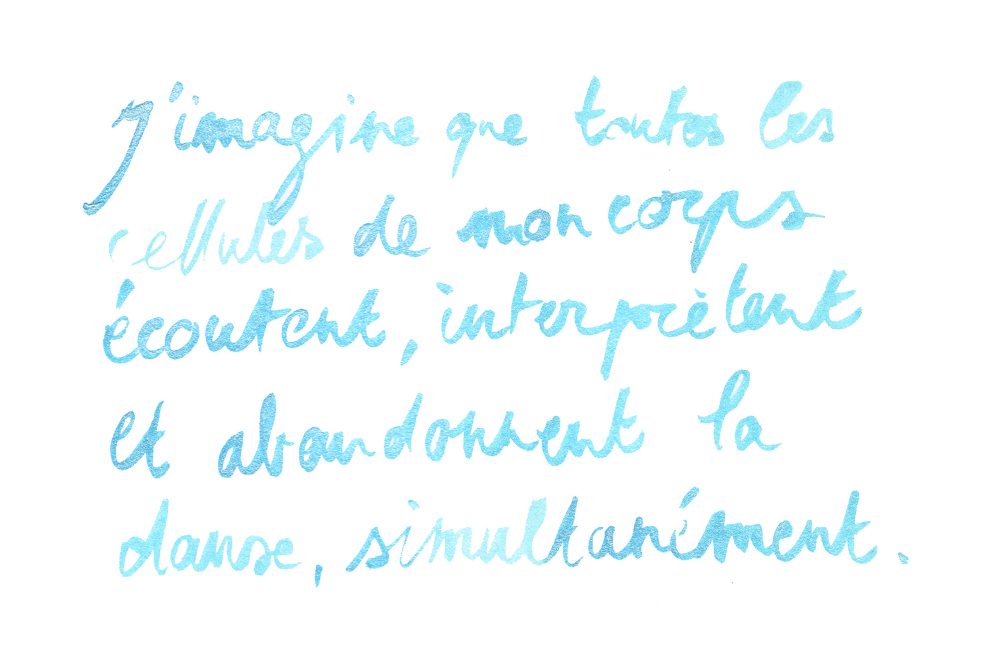Charlotte Herzig — Santé menthol
Vernissage | 16.05.2024, 18:00-21:00
When one first encounters Charlotte Herzig's paintings, one isn’t not quite sure how to bring them into focus. With Killjoystick (2024), should one rely on a general geometric structure like silver circles painted with gold leaf, covering parts of a vibrant yellow wall? Or do we cling to grids made up of tiles that seem to form a pattern (Holy Dip, 2024), or linger over triangles that appear to cut a repetitive swathe through the canvas (Stellar Stims, 2024)? Our irises nervously scan the possibilities of a language of abstraction that continuously plays with and challenges our comfort and habits formed by a long pictorial history. Although the broad paint surfaces cover the gallery's white cube walls, the washes and stamps sully them and, unexpectedly, give them relief. It is a gesture stemming from the tumult necessary to catch our eye somewhere and anchor it for a moment. Once accustomed to this apparent geometric notation, our eyes zoom in and out on signs that disrupt our tendency to go in circles. These little waves, for example, undulate like escaped sound waves, but from where? Perhaps from Emma Kunz's grotto in Würenlos or the Young and Zazeela’s “Dream House,” where Charlotte Herzig once served as caretaker? Or the Mojave Desert, where Pauline Oliveros liked to take her students to practise sonic meditations to increase their attention and listening skills. When Charlotte Herzig was a student at ECAL, she enjoyed taking naps near Emma Kunz's house while observing visitors look at her drawings or exit the grotto. The drawing that adorns the packaging of Aion A may have broken into many homes and announced their possible healing gifts, but it nonetheless delivers its visionary, profound amplitude when hung among Kunz's other drawings, composing a horizon where our gaze and our breath rest. Similarly, the waves and ripples in the Kunz’s paintings are motifs that have the property of transforming into waves, into frequencies, and thus can detach from the canvas. Thanks to the mobility they acquire, they shift us into a mental space freed from the constraints of ultra-liberalised time. Like the small painting Gooey A.F. (2024) that adorns the first mural on the ground floor or the second fresco painted upstairs, a horizon line emerges after a process of abstraction, of self-extraction: a possible escape from the capitalism of our fragmented lives. While Charlotte Herzig's paintings do not fully recreate a time untrammelled by privatisation (read or re-read Jonathan Crary's 24/7 Le Capitalisme à l'assaut du sommeil), which would embody public time as a common good, they do thwart its magical springs (read or re-read Philippe Pignare and Isabelle Stengers's La Sorcellerie capitaliste), which are based on optical illusion. It's a world made up of visual phenomena that are delicately placed before us, between building blocks for children's games and uncontrolled temporal ranges in front of which Sophie Ballmer and Tarik Hayward's chairs unfold. According to Charlotte Herzig, these chairs embody a wild strangeness between design and drawing, futurism and ecology: a dissonance in the perception of time that only reinforces the temporal suspension of the paintings.
At the start of our visit, the ultra-vitamined palette of colours and the jumble of geometric shapes electrified and exhilarated us, we emerge refocused, magnetised and aligned by the play of hangings and moods that the artist has carefully sequenced for us in each gallery room. Such is the limitless, mineral power of Charlotte Herzig: Aion A is where her painting arrives. – Geraldine Gourbe Biography Charlotte Herzig was born in 1983 in Vevey, Switzerland. She holds a Bachelor’s in Visual Arts (2007) from École Cantonale d’Art de Lausanne (ECAL) and a Master’s in Painting from the San Francisco Art Institute. She lives and works in Brussels, Belgium. In 2021, Herzig mounted a major exhibition at the Kunstmuseum Luzern (Switzerland). Herzig’s work has been featured at exhibitions including those at the Kunsthaus Pasquart (Biel, Switzerland), Tarmak22 (Gstaad, Switzerland), Swiss Institute (Rome, Italy), and Kunsthaus Langenthal (Switzerland).
Artist(s)
| Details | Name | Portrait |
|---|---|---|
| Charlotte Herzig |
Institutions
| Title | Country | City | Details |
|---|---|---|---|
| Wilde | Genève | Switzerland
|
Genève
|
Switzerland
Genève
|
